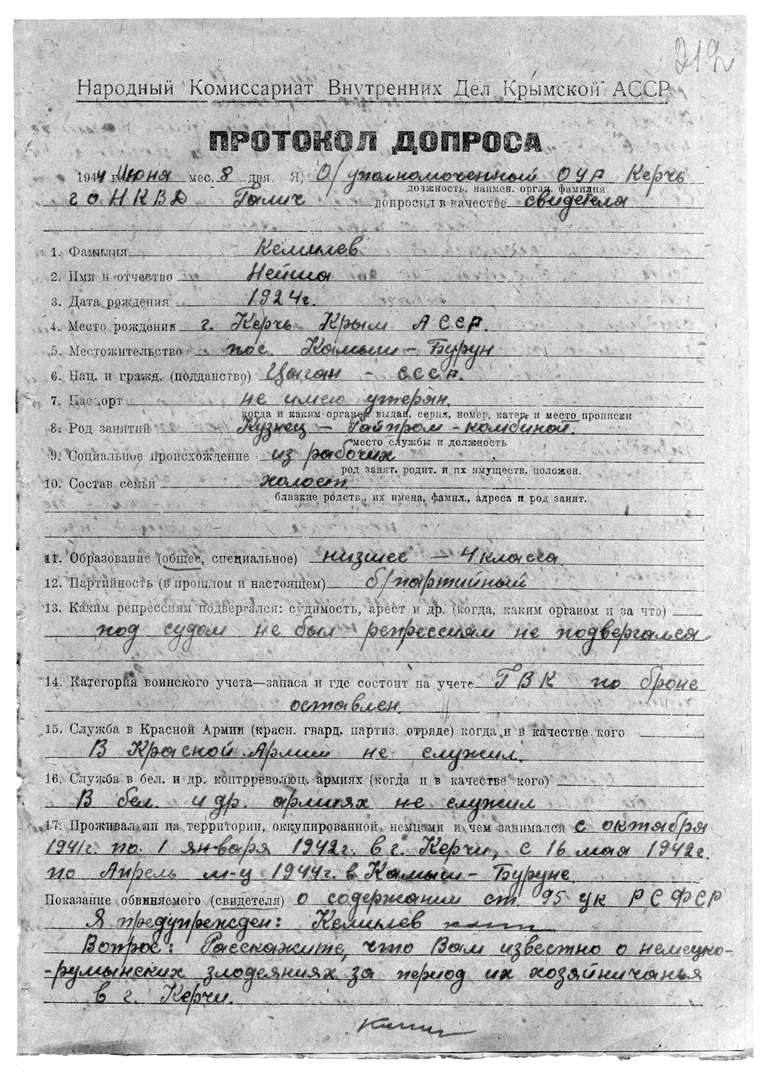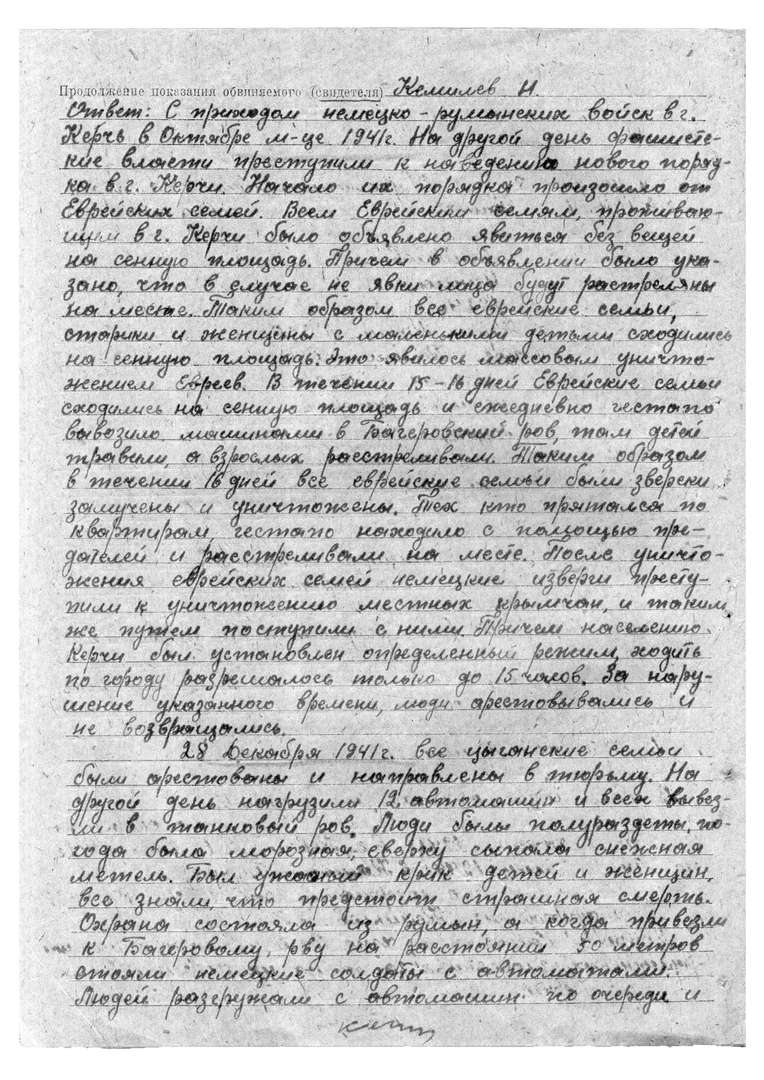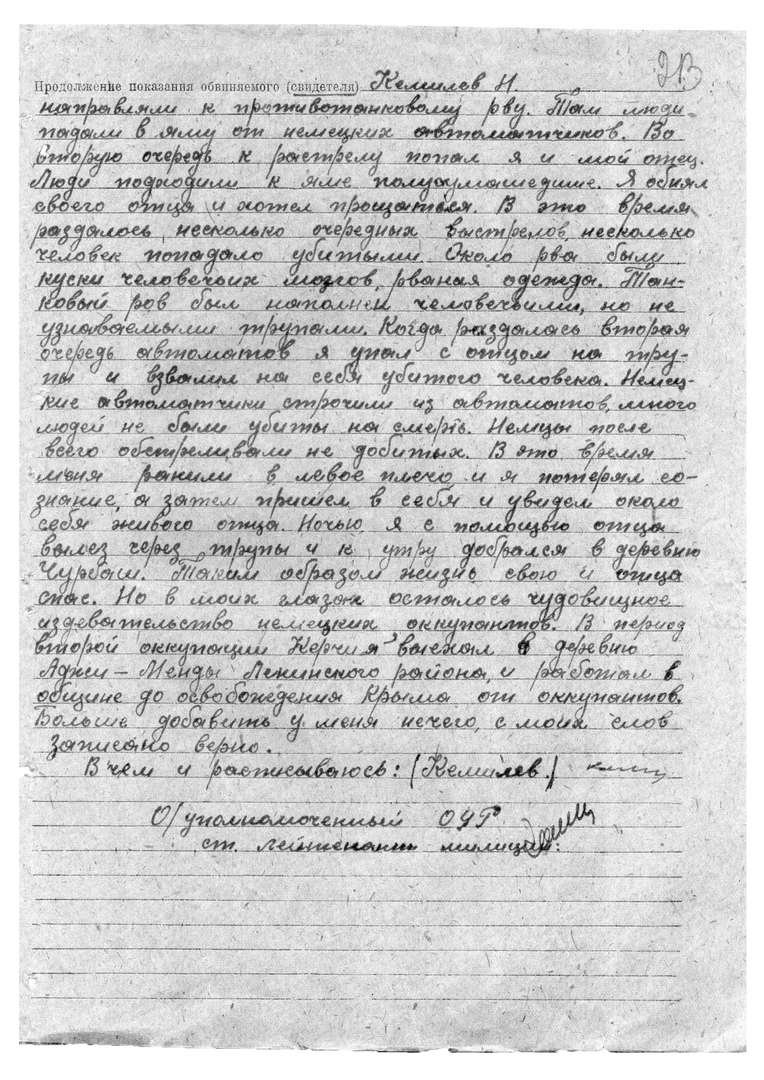Народный Комиссариат Внутренних Дел Крымской АССР
ПРОТОКОЛ ДОПРОСА
1944 г., июня мес.[яца] 8 дня. Я, О[перативный]/уполномоченный ОУР [Отдел Уголовного Розыска] Керчь г.о. НКВД Галич допросил в качестве свидетеля
- Фамилия: Кемилев
- Имя и отчество: Нейша
- Дата рождения: 1924 г.
- Место рождения: г. Керчь, Крым АССР
- Местожительство: пос.[елок] Камыш-Бурун
- Нац. и гражд. (подданство): Цыган – СССР
- Паспорт: Не имею, утерян
- Род занятий: Кузнец – Райпром-комбинат
- Социальное происхождение: Из рабочих
- Состав семьи: Холост.[ой]
- Образование (общее, специальное): низшее – 4 класса
- Партийность (в прошлом и настоящем): б/партийный
- Каким репрессиям подвергался: судимость, арест и др. (когда, каким органом и за что): Под судом не был, репрессиям не подвергался.
- Категория воинского учета – запаса и где состоит на учете: ГВК [Городской Военный Комиссариат] по броне оставлен.
- Служба в Красной Армии (красн. гвард. партиз. отряде) когда и в качестве кого: В Красной Армии не служил
- Служба в бел. [и] др. контрреволюц. армиях (когда и в качестве кого): В бел. и др. армиях не служил
- Проживал ли на территории, оккупированной немцами и чем занимался: С октября 1941 г. по 1 января 1942 г. в г. Керчи, с 16 мая 1942 г. по апрель м-ц 1944 г. в Камыш-Буруне.
Показания обвиняемого (свидетеля): О содержании ст.[атьи] 95 УК РСФСР я предупрежден: Кемилев [подпись]
Вопрос: Расскажите, что Вам известно о немецко-румынских злодеяниях за период их хозяйничанья в г. Керчи?
Ответ: С приходом немецко-румынских войск в г. Керчь в октябре м-це 1941 г. на другой день фашистские власти пр[и]ступили к наведению нового порядка в г. Керчи. Начало их порядка произошло от еврейских семей. Всем еврейским сем[ь]ям, проживающим в г. Керчи, было объявлено явиться без вещей на Cенную площадь. Причем в объявлении было указано, что в случае н[ея]вки лица [которые не явились] будут расстреляны на месте. Таким образом все еврейские семьи, старики и женщины с маленькими детьми сходились на Сенную площадь. Это явилось массовым уничтожением евреев. В течени[е] 15-16 дней еврейские семьи сходились на Сенную площадь, и ежедневно гестапо вывозило [их] машинами в Багеровский ров, там детей травили, а взрослых расстреливали. Таким образом в течени[е] 16 дней все еврейские семьи были зверски замучены и уничтожены. Тех, кто прятался по квартирам, гестапо находило с помощью предателей, и [найденных] расстреливали на месте. После уничтожения еврейских семей немецкие изверги приступили к уничтожению местных крымчан [т.е. крымчаков], и таким же путем поступили с ними. Причем населению Керчи был установлен определенный режим, ходить по городу разрешалось только до 15 часов. За нарушение указанного времени люди арестовывались и не возвращались.
28 декабря 1941 г. все цыcанские семьи были арестованы и направлены в тюрьму. На другой день нагрузили 12 автомашин и всех вывезли в танковый ров. Люди были полураздеты[ми], погода была морозная, сверху сыпала снежная метель. Был ужасный крик детей и женщин, все знали, что предстоит страшная смерть. Охрана состояла из румын, а когда привезли к Багеровскому рву на расстоянии 50 метров [от рва] стояли немецкие солдаты с автоматами. Людей разгружали с автомашин по очереди и направляли к противотанковому рву. Там люди падали в яму от [выстрелов] немецких автоматчиков. Во вторую очередь к расстрелу попал я и мой отец. Люди подходили к яме полусумасшедшие. Я обнял своего отца и хотел попрощаться. В это время раздалось несколько очередных выстрелов, несколько человек попадало убитыми. Около рва были куски человечьих мозгов, рваная одежда. Танковый ров был наполнен человечьими, но не узнаваемыми трупами. Когда раздалась вторая очередь автоматов я упал с отцом на трупы и взвалил на себя убитого человека. Немецкие автоматчики строчили из автоматов, много людей не были убиты на смерть. Немцы после всего обстреливали не добитых. В это время меня ранили в левое плечо, и я потерял сознание, а затем пришел в себя и увидел около себя живого отца. Ночью я с помощью отца вылез через трупы и к утру добрался в деревню Чурбаш. Таким образом жизнь свою и отца спас. Но в моих глазах осталось чудовищное издевательство немецких оккупантов. В период второй оккупации Керчи я выехал в деревню Аджи-Менды Ленинского района, и работал в общине до освобождения Крыма от оккупантов. Больше добавить у меня нечего, с моих слов записано верно.
В чем и расписываюсь: (Кемилев) [подпись]
О[перативный]/уполномоченный ОУР
ст.[арший] лейтенант милиции [подпись неразборчиво]











